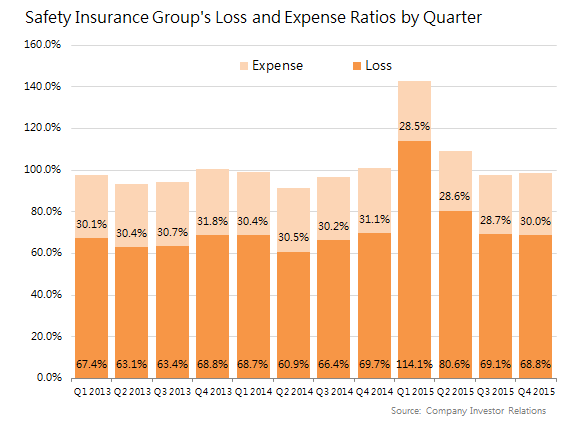Safety Insurance Group's (SAFT +0.51%) fourth-quarter results showed a return to normalcy, as loss rates fell, leading to improved underwriting results in the fourth quarter of 2015.
By the numbers
|
Metric |
4Q 2015 |
4Q 2014 |
|---|---|---|
|
Direct Written Premium |
$173.4 million |
$168.4 million |
|
Net Income |
$10.3 million |
$10.4 million |
|
Combined Ratio |
98.8% |
100.8% |
|
Book Value Per Share |
$42.70 |
$47.19 |
Data source: Company investor relations.
What happened this quarter?
After unusual catastrophe losses in the first quarter of 2014, Safety's underwriting is coming back in line with historical norms.
- Losses fell to 68.8% of premiums, down from 69.7% in the same quarter last year. Expenses also improved to 30% of premiums, down from 31.1%.
- Book value per share has fallen sharply (about 9.5%) year over year due to first-quarter losses but was stable quarter over quarter.
- Written premiums jumped due to premium increases and a rise in written exposures. The company reported that commercial auto premiums were up 6.1% per exposure during the quarter, while homeowners' premiums per exposure increased by 3.2%.
- The company's annual report discloses a number of rate increases that were approved by regulators in its core markets. In Massachusetts, it was approved for a 9.1% increase in homeowners' rates. In New Hampshire, it received approval for a 5% and 7.9% increase in rates on personal auto and homeowner insurance, respectively. All of the above rate increases went into effect on Nov. 1, 2015.

Looking ahead
Like all property and casualty insurers, Safety's business model remains highly rate sensitive. The company disclosed that its investment portfolio is currently generating a yield of about 3.2% per year, down from 3.6% in the fourth quarter of 2014, even though its average duration has increased.
The general level of interest rates remains a core driver of its earnings. This year, it earned about $41 million from net interest income, a decline from just over $42 million last year due to a drop in investment assets related to catastrophe losses earlier in the year.
With the end of the first quarter of 2016 just two weeks away, and with warmer winter weather in New England, Safety's first quarter appears promising.
